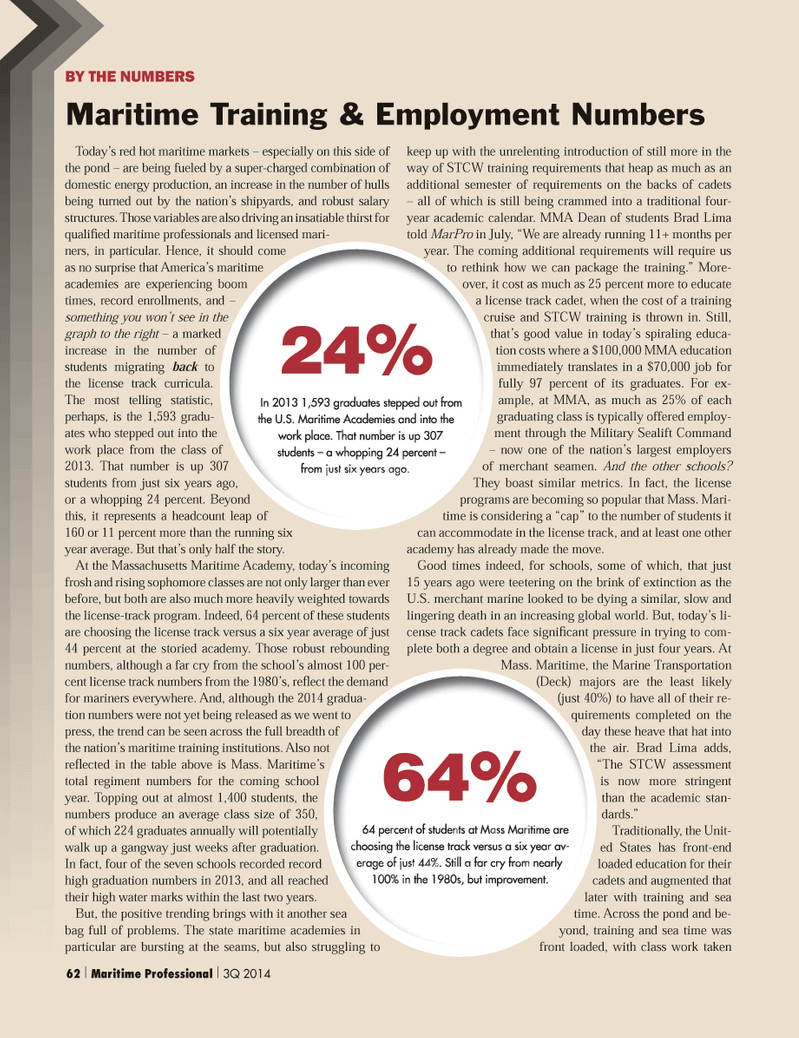
Page 62: of Maritime Logistics Professional Magazine (Q3 2014)
Power & Fuel Management
Read this page in Pdf, Flash or Html5 edition of Q3 2014 Maritime Logistics Professional Magazine
Recruitment BY THE NUMBERS Maritime Training & Employment Numbers Today?s red hot maritime markets ? especially on this side of the pond ? are being fueled by a super-charged combination of domestic energy production, an increase in the number of hulls being turned out by the nation?s shipyards, and robust salary structures. Those variables are also driving an insatiable thirst for quali ed maritime professionals and licensed mari- ners, in particular. Hence, it should come as no surprise that America?s maritime academies are experiencing boom times, record enrollments, and ? something you won?t see in the graph to the right ? a marked increase in the number of students migrating back to the license track curricula. The most telling statistic, perhaps, is the 1,593 gradu-ates who stepped out into the work place from the class of 2013. That number is up 307 students from just six years ago, or a whopping 24 percent. Beyond this, it represents a headcount leap of 160 or 11 percent more than the running six year average. But that?s only half the story. At the Massachusetts Maritime Academy, today?s incoming frosh and rising sophomore classes are not only larger than ever before, but both are also much more heavily weighted towards the license-track program. Indeed, 64 percent of these students are choosing the license track versus a six year average of just 44 percent at the storied academy. Those robust rebounding numbers, although a far cry from the school?s almost 100 per- cent license track numbers from the 1980?s, re ect the demand for mariners everywhere. And, although the 2014 gradua- tion numbers were not yet being released as we went to press, the trend can be seen across the full breadth of the nation?s maritime training institutions. Also not re ected in the table above is Mass. Maritime?s total regiment numbers for the coming school year. Topping out at almost 1,400 students, the numbers produce an average class size of 350, of which 224 graduates annually will potentially walk up a gangway just weeks after graduation. In fact, four of the seven schools recorded record high graduation numbers in 2013, and all reached their high water marks within the last two years. But, the positive trending brings with it another sea bag full of problems. The state maritime academies in particular are bursting at the seams, but also struggling to keep up with the unrelenting introduction of still more in the way of STCW training requirements that heap as much as an additional semester of requirements on the backs of cadets ? all of which is still being crammed into a traditional four- year academic calendar. MMA Dean of students Brad Lima told MarPro in July, ?We are already running 11+ months per year. The coming additional requirements will require us to rethink how we can package the training.? More- over, it cost as much as 25 percent more to educate a license track cadet, when the cost of a training cruise and STCW training is thrown in. Still, that?s good value in today?s spiraling educa- tion costs where a $100,000 MMA education immediately translates in a $70,000 job for fully 97 percent of its graduates. For ex- ample, at MMA, as much as 25% of each graduating class is typically offered employ- ment through the Military Sealift Command ? now one of the nation?s largest employers of merchant seamen. And the other schools? They boast similar metrics. In fact, the license programs are becoming so popular that Mass. Mari-time is considering a ?cap? to the number of students it can accommodate in the license track, and at least one other academy has already made the move. Good times indeed, for schools, some of which, that just 15 years ago were teetering on the brink of extinction as the U.S. merchant marine looked to be dying a similar, slow and lingering death in an increasing global world. But, today?s li- cense track cadets face signi cant pressure in trying to com- plete both a degree and obtain a license in just four years. At Mass. Maritime, the Marine Transportation (Deck) majors are the least likely (just 40%) to have all of their re- quirements completed on the day these heave that hat into the air. Brad Lima adds, ?The STCW assessment is now more stringent than the academic stan-dards.? Traditionally, the Unit- ed States has front-end loaded education for their cadets and augmented that later with training and sea time. Across the pond and be- yond, training and sea time was front loaded, with class work taken 62 | Maritime Professional | 3Q 201450-63 Q3 MP2014.indd 6250-63 Q3 MP2014.indd 628/15/2014 10:34:42 AM8/15/2014 10:34:42 AM

 61
61

 63
63
